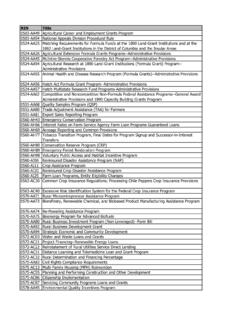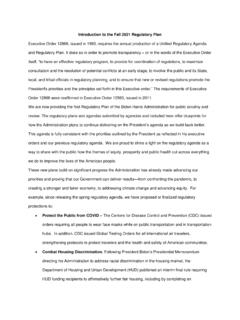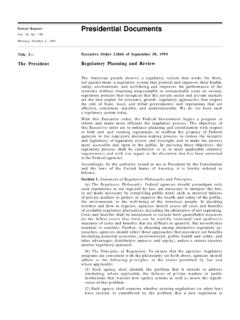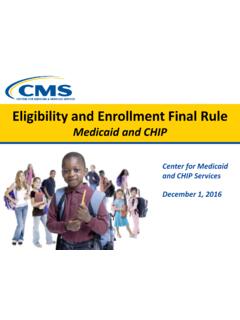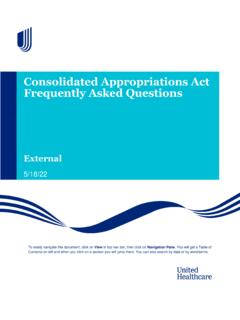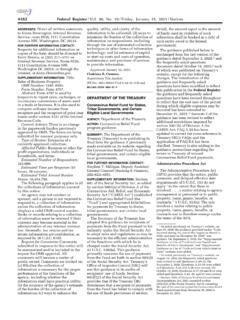Transcription of Federal Register Notice - REGINFO.GOV
1 VerDate Mar<15>2010 21:18 Jan 20, 2011 Jkt 223001 PO 00000 Frm 00001 Fmt 4705 Sfmt 4790 E:\FR\FM\ 21 JAE0 Emcdonald on DSK2 BSOYB1 PROD with NOTICES3821 Federal Register Presidential Documents Vol. 76, No. 14 Friday, January 21, 2011 Title 3 The President Executive Order 13563 of January 18, 2011 Improving Regulation and Regulatory Review By the authority vested in me as President by the Constitution and the laws of the United States of America, and in order to improve regulation and regulatory review, it is hereby ordered as follows: Section 1.
2 General Principles of Regulation. (a) Our regulatory system must protect public health, welfare, safety, and our environment while promoting economic growth, innovation, competitiveness, and job creation. It must be based on the best available science. It must allow for public participation and an open exchange of ideas. It must promote predictability and reduce uncertainty. It must identify and use the best, most innovative, and least burdensome tools for achieving regulatory ends.
3 It must take into account benefits and costs, both quantitative and qualitative. It must ensure that regulations are accessible, consistent, written in plain language, and easy to understand. It must measure, and seek to improve, the actual results of regulatory requirements. (b) This order is supplemental to and reaffirms the principles, structures, and definitions governing contemporary regulatory review that were estab lished in Executive Order 12866 of September 30, 1993.
4 As stated in that Executive Order and to the extent permitted by law, each agency must, among other things: (1) propose or adopt a regulation only upon a reasoned determination that its benefits justify its costs (recognizing that some benefits and costs are difficult to quantify); (2) tailor its regulations to impose the least burden on society, consistent with obtaining regulatory objectives, taking into account, among other things, and to the extent practicable, the costs of cumulative regulations; (3) select, in choosing among alternative regulatory approaches, those approaches that maximize net benefits (including potential economic, environmental, public health and safety, and other advantages; distributive impacts; and equity).
5 (4) to the extent feasible, specify perform ance objectives, rather than specifying the behavior or manner of compliance that regulated entities must adopt; and (5) identify and assess available alternatives to direct regulation, including providing economic incentives to encourage the desired behavior, such as user fees or marketable permits, or providing information upon which choices can be made by the public. (c) In applying these principles, each agency is directed to use the best available techniques to quantify anticipated present and future benefits and costs as accurately as possible.
6 Where appropriate and permitted by law, each agency may consider (and discuss qualitatively) values that are difficult or impossible to quantify, including equity, human dignity, fairness, and distributive impacts. Sec. 2. Public Participation. (a) Regulations shall be adopted through a process that involves public participation. To that end, regulations shall be based, to the extent feasible and consistent with law, on the open exchange of information and perspectives among State, local, and tribal officials, ex perts in relevant disciplines, affected stakeholders in the private sector, and the public as a whole.
7 (b) To promote that open exchange, each agency, consistent with Executive Order 12866 and other applicable legal requirements, shall endeavor to provide the public with an opportunity to participate in the regulatory process. To the extent feasible and permitted by law, each agency shall afford the public a meaningful opportunity to comment through the Internet on any proposed regulation, with a comment period that should generally VerDate Mar<15>2010 21:18 Jan 20, 2011 Jkt 223001 PO 00000 Frm 00002 Fmt 4705 Sfmt 4790 E:\FR\FM\ 21 JAE0 Emcdonald on DSK2 BSOYB1 PROD with NOTICES3822 Federal Register / Vol.
8 76, No. 14 / Friday, January 21, 2011 / Presidential Documents be at least 60 days. To the extent feasible and permitted by law, each agency shall also provide, for both proposed and final rules, timely online access to the rulemaking docket on , including relevant sci entific and technical findings, in an open format that can be easily searched and downloaded. For proposed rules, such access shall include, to the extent feasible and permitted by law, an opportunity for public comment on all pertinent parts of the rulemaking docket, including relevant scientific and technical findings.
9 (c) Before issuing a Notice of proposed rulemaking , each agency, where feasible and appropriate, shall seek the views of those who are likely to be affected, including those who are likely to benefit from and those who are potentially subject to such rulemaking . Sec. 3. Integration and Innovation. Some sectors and industries face a signifi cant number of regulatory requirements, some of which may be redundant, inconsistent, or overlapping. Greater coordination across agencies could re duce these requirements, thus reducing costs and simplifying and harmo nizing rules.
10 In developing regulatory actions and identifying appropriate approaches, each agency shall attempt to promote such coordination, sim plification, and harmonization. Each agency shall also seek to identify, as appropriate, means to achieve regulatory goals that are designed to promote innovation. Sec. 4. Flexible Approaches. Where relevant, feasible, and consistent with regulatory objectives, and to the extent permitted by law, each agency shall identify and consider regulatory approaches that reduce burdens and main tain flexibility and freedom of choice for the public.
